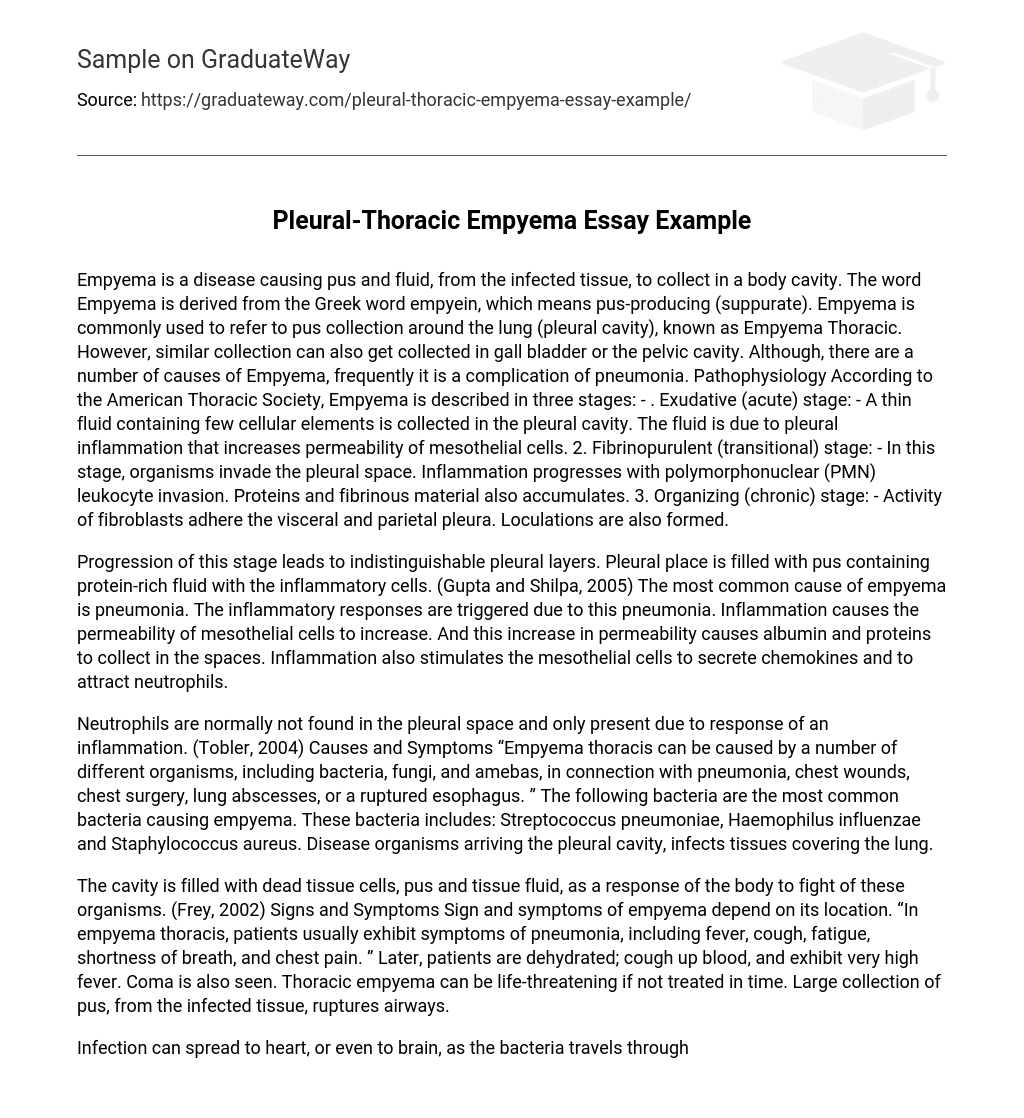Empyema is a disease causing pus and fluid, from the infected tissue, to collect in a body cavity. The word Empyema is derived from the Greek word empyein, which means pus-producing (suppurate). Empyema is commonly used to refer to pus collection around the lung (pleural cavity), known as Empyema Thoracic. However, similar collection can also get collected in gall bladder or the pelvic cavity. Although, there are a number of causes of Empyema, frequently it is a complication of pneumonia. Pathophysiology According to the American Thoracic Society, Empyema is described in three stages: – . Exudative (acute) stage: – A thin fluid containing few cellular elements is collected in the pleural cavity. The fluid is due to pleural inflammation that increases permeability of mesothelial cells. 2. Fibrinopurulent (transitional) stage: – In this stage, organisms invade the pleural space. Inflammation progresses with polymorphonuclear (PMN) leukocyte invasion. Proteins and fibrinous material also accumulates. 3. Organizing (chronic) stage: – Activity of fibroblasts adhere the visceral and parietal pleura. Loculations are also formed.
Progression of this stage leads to indistinguishable pleural layers. Pleural place is filled with pus containing protein-rich fluid with the inflammatory cells. (Gupta and Shilpa, 2005) The most common cause of empyema is pneumonia. The inflammatory responses are triggered due to this pneumonia. Inflammation causes the permeability of mesothelial cells to increase. And this increase in permeability causes albumin and proteins to collect in the spaces. Inflammation also stimulates the mesothelial cells to secrete chemokines and to attract neutrophils.
Neutrophils are normally not found in the pleural space and only present due to response of an inflammation. (Tobler, 2004) Causes and Symptoms “Empyema thoracis can be caused by a number of different organisms, including bacteria, fungi, and amebas, in connection with pneumonia, chest wounds, chest surgery, lung abscesses, or a ruptured esophagus. ” The following bacteria are the most common bacteria causing empyema. These bacteria includes: Streptococcus pneumoniae, Haemophilus influenzae and Staphylococcus aureus. Disease organisms arriving the pleural cavity, infects tissues covering the lung.
The cavity is filled with dead tissue cells, pus and tissue fluid, as a response of the body to fight of these organisms. (Frey, 2002) Signs and Symptoms Sign and symptoms of empyema depend on its location. “In empyema thoracis, patients usually exhibit symptoms of pneumonia, including fever, cough, fatigue, shortness of breath, and chest pain. ” Later, patients are dehydrated; cough up blood, and exhibit very high fever. Coma is also seen. Thoracic empyema can be life-threatening if not treated in time. Large collection of pus, from the infected tissue, ruptures airways.
Infection can spread to heart, or even to brain, as the bacteria travels through the bloodstreams. In pelvic empyema, large amount of foul-smelling pus is produces rapidly. The pus is replaced even if drained. Intense pain of abdomen, high fever, and the rigidity of muscles, characterizes Empyema of gallbladder. (Frey, 2002) Diagnosis Diagnosis can be made using a stethoscope. The sounds of breathing will be muffled in the stethoscope and when the chest is tapped, the sound produced is very dull. Chest X ray gives a cloudy appearance, of the infected area. Ultrasound is used to determine the amount of fluid present.
Although these techniques are used in the diagnosis, empyema is only confirmed using lab tests. Fluid of the pleural cavity is analyzed. A process, known as thoracentesis, is used to take the sample from the patient’s chest. This fluid is rich in white blood cells and proteins and low in blood sugar level. (Frey, 2002) Treatment A combination of medications and surgical techniques are used to treat Empyema. In the treatment with medications, intravenous antibiotics are given. Antibiotics prevent the first-stage from progressing. The commonly used antibiotics comprises of names like penicillin and vancomycin.
Oxygen therapy is also given to patients who have difficulty in breathing. Surgical treatment is used to drain the infected fluid and to close the space produced in the pleural cavity. In early stages, thoracentesis is used. Thoracentesis is only effective for the earlier stages of empyema. A chest tube or small-bore catheter is placed if the continuous drainage is required. Ultrasonograph or CT scans are used for guidance in placing the small-bore catheter. Surgical interventions are needed for the loculations that did not drain or if multiple loculations are present.
Eventhough, fibrinolytic therapy has reduced the requirement of surgery; surgery does become a requirement in some cases. Fibrinolytics are efficient as they decrease viscosity of the effusions and dissolve some of the adhesions. During surgery, Video-assisted thoracoscopic surgery (VATS) is also used by a lot of physicians to position the chest tube or performing decortication. Video-assisted thoracoscopic surgery (VATS) allows the surgeons to see inside the body. This technique has reduced the need for an open surgery. (Frey, 2002)





